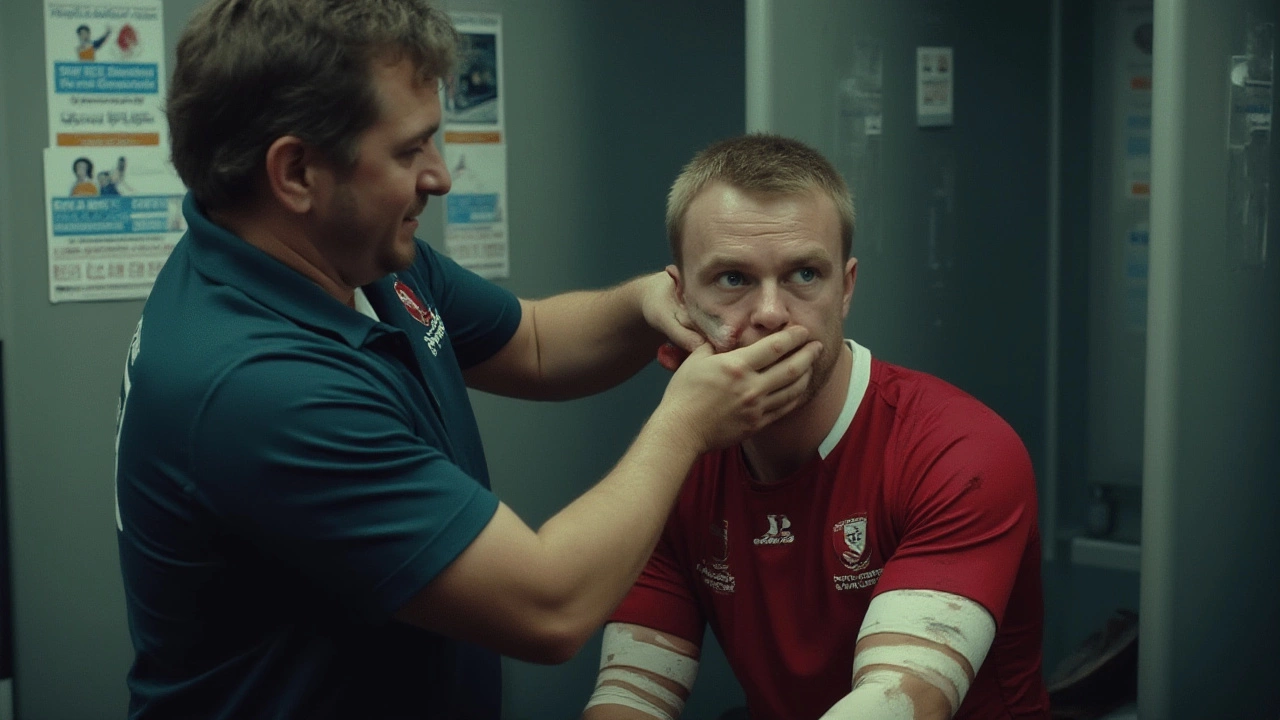There’s something wild about rugby—its grit, raw action, and the fact that blood can literally become part of the game. Ever heard the crowd roar as the ref points a player off because there’s blood trickling down his face? That situation has a special name in rugby. It’s not just called a ‘bleed’ or an ‘injury timeout.’ It’s something unique. This isn’t about violence or glorifying pain; it’s about rules, player safety, and one of the quirkiest terms in all of sport. So, what do they actually call it when there’s blood in rugby?
The Blood Bin: Rugby’s Unique Approach to Bleeding
When a player starts bleeding on a rugby field, refs send them to what’s called the “blood bin.” No, that's not some gruesome locker room—it's just the nickname rugby folks use when a player must temporarily leave the field because of a visible bleeding injury. The term ‘blood bin’ was first widely adopted in the 1990s, following stricter regulations from rugby authorities to stop blood exposure due to rising concerns about the spread of bloodborne diseases like HIV and hepatitis.
In rugby, play is tough and collisions are frequent. A stray boot, an unlucky knock in a ruck, or even an elbow from your own teammate can open up skin. When blood is visible, even if it’s just a nosebleed or a minor cut, the rules say the player has to go off—immediately. Once off, they get medical attention. They can come back, but only if the bleeding has stopped and the wound is properly covered. And if you’re thinking players just tape over a wound and rush on? Think again. Rugby’s medical staff takes this seriously. The referee has the power to inspect a returning player, and won’t hesitate to keep someone off if there's even the tiniest doubt.
This whole process isn’t just about a tidy field. Rugby’s governing bodies have made blood protocols mandatory to protect everyone: the bleeding player, the opponents, the referee, and, honestly, anyone who handles the ball. In the old days, players would keep going with barely a glance at a gash—now, player safety rules. Strict enforcement of the blood bin started when doctors began to understand how fast diseases can spread through open wounds during a tackle or scrum.
Not all sports are this strict. Rugby stands out for how seriously it approaches bleeding, with the constant risk of close physical contact. The blood bin isn’t optional, and players who argue with a ref’s decision don’t stay on the field long. Fans sometimes see the drama as a badge of honor, but for the modern game, getting the player treated—and the field cleaned up—is a top priority.
How the Blood Bin Works: Steps, Stories, and Oddities
Here’s how it goes down: The referee spots blood—maybe it’s streaming from a forehead gash or dripping onto a jersey. The call is made: "Blood bin!" The player heads to the sideline, and a temporary substitute comes in. Under international rugby rules—specifically, World Rugby Law 3—the blood rule is crystal clear. The substituted player has 15 minutes (actual game time, not running clock) to get patched up. If they’re ready, they can come back. If not, the substitution becomes permanent.
The really interesting twist? This “blood bin” sub is the only kind of substitution in rugby that doesn’t count against the team’s usual limit of eight replacements for the match. It’s designed so player safety doesn’t penalize the whole team. If you ever spot two or three players dashing off at once after a scrum collapse, there’s probably blood somewhere, even if you can’t see it on TV.
Clever coaches have, on occasion, tried to exploit this rule. There have been infamous moments—take the ‘Bloodgate’ scandal involving English club Harlequins in 2009. Staff faked a blood injury by using a capsule filled with fake blood in a player's mouth. Why? To sneak on a strategic substitute late in a match. The fallout from that drama was massive: bans, fines, and a rewrite of regulations. The debacle only made the blood bin rules even tighter.
And talk about drama—players are sometimes desperate to stay on. There’ve been wild scenes with props or back-rowers wiping their wounds on their shorts or shirts just to hide bleeding. Medics, referees, and teammates are now pretty sharp at catching this. Some fans argue the rule interrupts the game’s flow, but the risk isn’t worth ignoring.

The Science and Safety Behind Rugby's Blood Protocols
Rugby didn’t invent the idea of removing bleeding players, but it’s probably the sport most associated with ‘the blood bin.’ Medical science is the backbone here. Even a tiny spot of blood can carry pathogens, and when you think about how often a player’s open palm, face, or bandaged knee touches the ball, it’s obvious why rules are so tight.
The blood bin isn’t just about stopping infection. It’s also about making sure players aren’t exposed to more serious injury. A player with a head wound might be concussed, or too dazed to tackle safely. No, it’s not just blood you can see—if there's reason to worry about the nature of an injury, they’re off the pitch while medical checks happen.
A fun fact: some of the most memorable images in rugby history show legends bandaged and battered, tape across their heads, jerseys streaked with blood. That used to be a symbol of toughness—now, with the blood bin, you’ll rarely see those scenes for long. Modern waterproof bandages and quick action from medical teams limit drama, but they also help players heal and get back safely.
Preventing infection matters off the pitch too. Blood on jerseys or gear? It must be cleaned or swapped before play resumes. Rugby even has specific brands of cleaning wipes and sprays approved for sanitizing blood off the ball and the grass. If the ref finds blood residue anywhere—on the ball, the field, even the posts—the game pauses. It’s not just a good look, it’s essential.
Tactics, Tips, and What Players Really Think About the Blood Bin
So is there a way for players to avoid the blood bin, short of wearing a full suit of armor? Not really. But you’ll notice more players wearing headgear, protective padding, and using skin glue or butterfly sutures applied on the sideline. The goal is simple: patch up and get back out there faster. A lot of pros carry a bandage in their sock just in case.
Some positions are notorious for bleeding. Props and flankers—the guys at the front of the scrum and in the thick of rucks—see the blood bin more than speedy backs do. If you talk to pros, many say the worst part isn’t the blood itself, but the break in match rhythm. For a highly conditioned athlete, leaving the pitch, even for five minutes, can mess with heart rate and adrenaline. Coaches now train squads to stay calm and organized when an unexpected blood sub happens.
If you’re starting out as a rugby player, get familiar with blood bin rules. Know what a ref looks for (bleeding, visible wounds, blood on gear). Learn to signal for help if you or a teammate needs it. Always keep a clean change of gear nearby—refs check for blood on shorts, socks, and shirts. And if you want to get back on quickly, cooperate with the medics. Sometimes a stubborn player can cost precious minutes if the wound isn’t cleaned and covered the first time.
To sum up, the blood bin isn’t just trivia—it’s a core part of rugby’s identity now. It’s about sport evolving, putting player welfare above old-school macho displays, and making sure the game we love stays as safe as possible, even when the going gets messy. Next time you see the ref send someone off for a bleeding eyebrow or a knocked tooth, remember there’s a world of smart science, strict protocol, and rugby legend at play behind that one simple, strange-sounding phrase: the blood bin.
